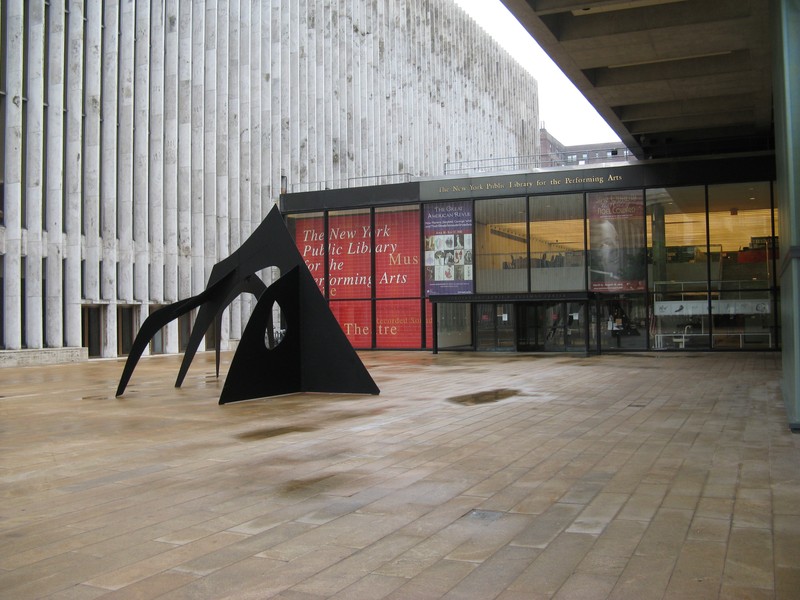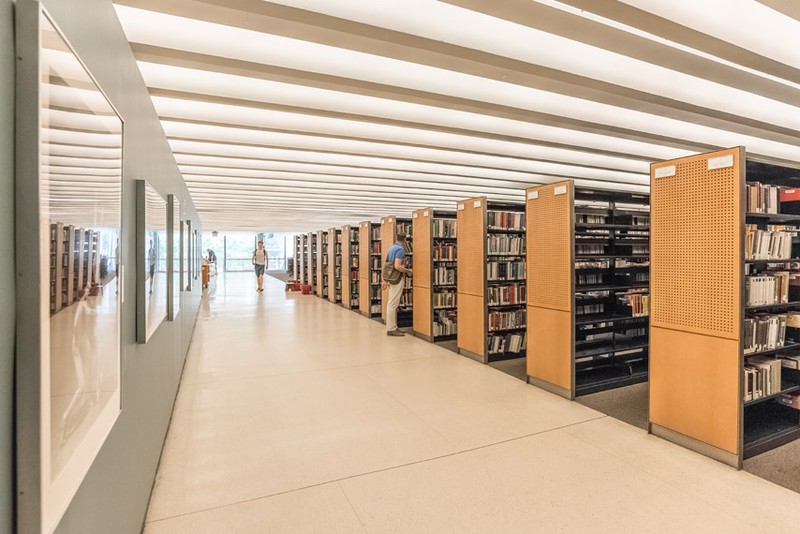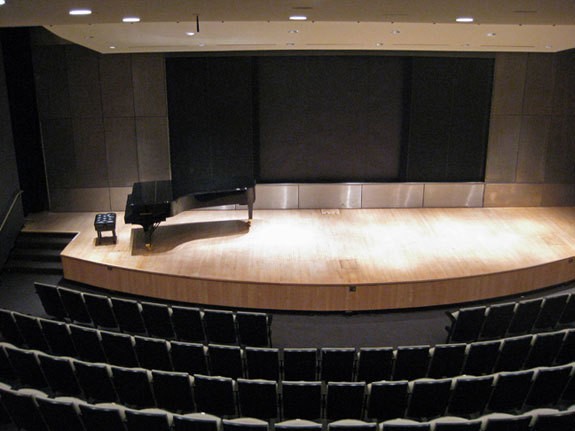New York Public Library for the Performing Arts
Introduction
Text-to-speech Audio
This branch of the New York Public Library is part of the Lincoln Center complex and is home of one of the world's largest collections of library materials related to the performing arts. These materials may be viewed free of charge and some may be checked out to library card holders. The library also offers special programs such as special exhibitions of materials from its collections, lectures performances, and traveling exhibits. The library is located near the north side of the Metropolitan Opera House in Lincoln Center Plaza and shares a building with the Vivian Beaumont Theater.
The library includes the Billy Rose Theatre Division, one of the world’s largest and most comprehensive archives devoted to the theatrical arts; the Jerome Robbins Dance Division, the largest and most comprehensive archive in the world devoted to the documentation of dance; the Music Division, which contains one of the world's preeminent music collections; and the Rodgers and Hammerstein Archives of Recorded Sound, one of the richest resources of recorded sound in the world.
The library has been open since 1965. In 2015, the library was voted Best Public Library by the Village Voice. “If you need to catch up on your John Ford westerns or map the differences and similarities between the styles of Isadora Duncan and Martha Graham, or get to the bottom, once and for all, of the sound of John Cage," the Village Voice reported, "the New York Public Library for the Performing Arts is where you want to be.”
Images
Exterior of The New York Public Library for the Performing Arts at Lincoln Center (with Alexander Calder's sculpture "Le Guichet")

Interior of The New York Public Library for the Performing Arts

The Bruno Walter Auditorium (capacity: 212)

Backstory and Context
Text-to-speech Audio
The collections now housed at the New York
Public Library for the Performing Arts (or LPA) were originally stored at two public libraries in the system: the
main branch, now named the Stephen A. Schwarzman Building (the research collections
for dance, music and theatre), and the 58th Street branch
(the circulating music collection). The idea of a separate building to house the
collections was broached as early as 1932, but it was only after Lincoln Center
was incorporated in 1956 that planning actually began. The library was combined in the same building with the Vivian Beaumont
Theater (also part of Lincoln Center) to save costs. The LPA was designed by Gordon Bunshaft of Skidmore, Owings, and Merrill (SOM) in the International Style to match the style of the rest of Lincoln Center. The Beaumont occupies the northern side of the
building while the LPA's first and second floors occupy the southern and
western sides, with the library’s third floor research collections providing
the roof. On the plaza near the entrance is a large stabile, designed by famous sculptor Alexander Calder, titled "Le Guichet." The LPA houses the following collections:
The Billy Rose Theatre Division - This division contains an enormous collection of personal papers and organizational records, scrapbooks, photographs, posters, programs, reviews and scripts. It also provide access to an array of traditional published books and journals, as well as a circulating collection of theatre books, scripts, videos and music. Particularly noteworthy is the division's efforts to document live theatre through the Theatre on Film and Tape (TOFT) Archive. Since 1970, TOFT has been photographing theatrical productions with the approval of Actor’s Equity; there are over 5000 tapes in the archive, including the original production of the classic musical A Chorus Line. “Last year we had researchers from 35 countries and 47 states, with quite a few artists from regional theatres throughout the United States,” says TOFT archive Director Patrick Hoffman.
The Jerome Robbins Dance Division - Chronicling the art of dance in all its forms - ballet, ethnic, modern, social and folk - the division is part museum, part film production center and part consulting service to the world of professional dance. The Jerome Robbins Archive of the Recorded Moving Image, the film and videotape archive of the division, began when the library first opened in 1965, with six cans of film donated by choreographer Jerome Robbins. The archive has grown to over 25,000 film and video titles.
The Music Division - Documenting the diverse art of music - classical, popular and world music alike - the division's curatorial mandate places major emphasis on capturing the creative output of contemporary composers. This division also contains the American Music Collection, which includes documents like the first edition of "The Star-Spangled Banner," native American songs, and manuscript collections of American composers like Henry Cowell, John Cage and Louis Moreau Gottschalk.
The Rodgers and Hammerstein Archives of Recorded Sound - The archives' holdings cover virtually every type of recorded sound, from orchestral works and pop recordings to speeches, radio programs and TV shows. It is both a research facility for performers, musicians, scholars and critics, and a leader in recording preservation efforts, as it is continually developing technology to transfer sound from obsolete to accessible formats.
Recently, a journalist, reporting on the 50th anniversary of the library’s opening, was shown manuscripts written by Mozart and Beethoven, the score of a musical written by the novelist F. Scott Fitzgerald when he was at Princeton, a first edition of the Gershwin opera Porgy and Bess and the original handwritten liner notes by jazz pianist Bill Evans for the classic Miles Davis album Kind of Blue. She was also shown wax cylinder recordings of the Metropolitan Opera from the early 20th Century; costume sketches for ballerina Natalya Goncharova for Igor Stravinsky’s composition, Les Noces, choreographed by Nijinsky; and models for stage sets for the musical Cabaret, including a miniature model of actor Joel Grey.
The Billy Rose Theatre Division - This division contains an enormous collection of personal papers and organizational records, scrapbooks, photographs, posters, programs, reviews and scripts. It also provide access to an array of traditional published books and journals, as well as a circulating collection of theatre books, scripts, videos and music. Particularly noteworthy is the division's efforts to document live theatre through the Theatre on Film and Tape (TOFT) Archive. Since 1970, TOFT has been photographing theatrical productions with the approval of Actor’s Equity; there are over 5000 tapes in the archive, including the original production of the classic musical A Chorus Line. “Last year we had researchers from 35 countries and 47 states, with quite a few artists from regional theatres throughout the United States,” says TOFT archive Director Patrick Hoffman.
The Jerome Robbins Dance Division - Chronicling the art of dance in all its forms - ballet, ethnic, modern, social and folk - the division is part museum, part film production center and part consulting service to the world of professional dance. The Jerome Robbins Archive of the Recorded Moving Image, the film and videotape archive of the division, began when the library first opened in 1965, with six cans of film donated by choreographer Jerome Robbins. The archive has grown to over 25,000 film and video titles.
The Music Division - Documenting the diverse art of music - classical, popular and world music alike - the division's curatorial mandate places major emphasis on capturing the creative output of contemporary composers. This division also contains the American Music Collection, which includes documents like the first edition of "The Star-Spangled Banner," native American songs, and manuscript collections of American composers like Henry Cowell, John Cage and Louis Moreau Gottschalk.
The Rodgers and Hammerstein Archives of Recorded Sound - The archives' holdings cover virtually every type of recorded sound, from orchestral works and pop recordings to speeches, radio programs and TV shows. It is both a research facility for performers, musicians, scholars and critics, and a leader in recording preservation efforts, as it is continually developing technology to transfer sound from obsolete to accessible formats.
Recently, a journalist, reporting on the 50th anniversary of the library’s opening, was shown manuscripts written by Mozart and Beethoven, the score of a musical written by the novelist F. Scott Fitzgerald when he was at Princeton, a first edition of the Gershwin opera Porgy and Bess and the original handwritten liner notes by jazz pianist Bill Evans for the classic Miles Davis album Kind of Blue. She was also shown wax cylinder recordings of the Metropolitan Opera from the early 20th Century; costume sketches for ballerina Natalya Goncharova for Igor Stravinsky’s composition, Les Noces, choreographed by Nijinsky; and models for stage sets for the musical Cabaret, including a miniature model of actor Joel Grey.
Sources
About the New York Public Library for the Performing Arts. New York Public Library. Accessed 4/29/17. http://www.nypl.org/about/locations/lpa.
New York Public Library for the Performing Arts. NYC-ARTS. Accessed 4/29/17. http://www.nyc-arts.org/organizations/281/new-york-public-library-for-the-performing-arts.
Larson, Sarah. THE MAGNIFICENT NEW YORK PUBLIC LIBRARY FOR THE PERFORMING ARTS. The New Yorker. 2/10/16. Accessed 4/29/17. http://www.newyorker.com/culture/sarah-larson/the-magnificent-new-york-public-library-for-the-performing-arts.
New York Public Library for the Performing Arts. The Village Voice. Accessed 4/29/17. http://www.villagevoice.com/best-of/2015/shopping-and-services/best-public-library-7782270.
New York Public Library For The Performing Arts - History - Founding and Original Configuration. Search. Accessed 4/29/17. http://www.liquisearch.com/new_york_public_library_for_the_performing_arts/history/founding_and_original_configuration.
New York Public Library for the Performing Arts. NYC-ARTS. Accessed 4/29/17. http://www.nyc-arts.org/organizations/281/new-york-public-library-for-the-performing-arts.
Larson, Sarah. THE MAGNIFICENT NEW YORK PUBLIC LIBRARY FOR THE PERFORMING ARTS. The New Yorker. 2/10/16. Accessed 4/29/17. http://www.newyorker.com/culture/sarah-larson/the-magnificent-new-york-public-library-for-the-performing-arts.
New York Public Library for the Performing Arts. The Village Voice. Accessed 4/29/17. http://www.villagevoice.com/best-of/2015/shopping-and-services/best-public-library-7782270.
New York Public Library For The Performing Arts - History - Founding and Original Configuration. Search. Accessed 4/29/17. http://www.liquisearch.com/new_york_public_library_for_the_performing_arts/history/founding_and_original_configuration.
